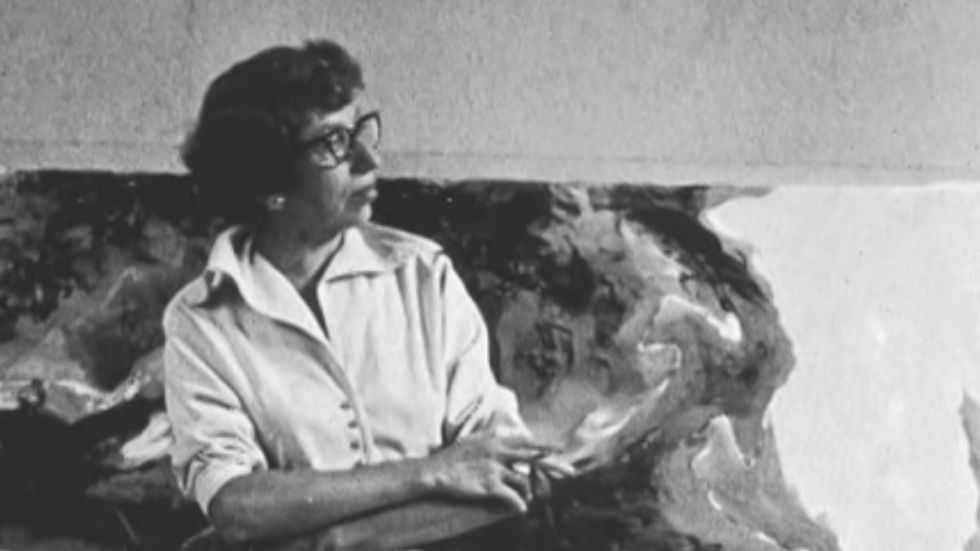Lee Krasner was an abstract expressionist artist whose unapologetic charisma and vision is a relic for women trying to break into the art world.
Breaking into a male-dominated art world with a culture of the male gaze objectifying women was no easy task. Women post-war were no longer needed in major roles and reduced to domesticated life, which would ironically be used as source material for their depictions. For most, it was like looking through a glass window.
Art history is no stranger to the marginalization of its talented female artists. From leaving works uncredited, refusing to display, sexualizing the creators, to denouncing successful women as a husband's arm candy.
Marrying fellow artist Jackson Pollack in 1945 would condemn Krasner to his shadows. This rings true for many women whom the media ignore and write off as solely muses. To be a source of inspiration is a compliment, but Krasner was more than that. That's enough talk of him.
Brooklyn-born, she had grown up with paint and had an eye for composition. Dedicating adolescent years to studio art, Krasner made regular submissions. She would continue her art training at Cooper Union, National Academy of Design Art and Students League of New York.
It was unfortunate for Krasner to be priming herself for the historically flimsy field with the Great Depression striking. A period of economic downturn would leave a harrowing trail on the quality of life.
Art would be sidestepped as aspiring artists sought any job to get food on the table. To work full-time as an artist inconsistently was impossible for creators of modest backgrounds. Especially for Krasner, the child of immigrant parents from Russia, fleeing anti-Semitism.
Juggling several odd positions, Krasner did everything from waiting on tables to modeling. With the state of society and her class oppression, Krasner's dream was not abandoned. She continued to make art in her minimal spare time.
A light would appear through a position gained from these struggles in the form of Franklin D. Roosevelt's New Deal efforts. He was dedicated to documenting the struggles of people and giving women a chance to finally shine.
In 1938, Krasner was assigned the task of enlarging artists’ sketches into murals. Her most popular work stands at converting a drawing by Leonard Jenkins into a towering 100-foot History of Navigation mural. Its final destination was for a children’s library in her home borough. She would continue to find employment for Works Progress Administration's Public Works of Art Project until 1943, when it was disbanded.
History of Navigation epitomized her capabilities for grandiose features and understanding of dimensions, a style marker. French artist Henri Matisse's Fauvist work to incorporate the burst of bright color to pop the canvas and Piet Mondrian's grid as inspiration for filling up a canvas and making every piece purposeful are accredited inspirations too.
Her most famous work is "The Seasons." Finished in 1957 with oil and house paint on canvas, its jarring usage of disproportionate and rapid brushstrokes are confrontational. Aggressive and dominating brushstrokes command her canvas. Colossally scaled, spectators can inspect every inch. The painting's round forms and blocks of color confront the audience. "The Seasons" is in the permanent collection of the Whitney Museum of American Art, fitting for a museum founded by a woman.
Another notable collaboration is Krasner coming full-circle in a project she shared with her nephew Ronald Stein. Collaborating for their mosaic mural in 1959 for the Uris Building, it found a home on 2 Broadway in Manhattan.
Her esteemed collection is minimal compared to her years active, however, there is a reason for that. Krasner rejected permanence. Creating collages, she would disassemble artworks and then merge them to create a new, final version in the spirit of Dadaist anarchy.
Krasner would become adored for her lively personality. But her connections in high places, as well as her fearsome and independent persona, could not withstand the pressures of society. Separating women from art was difficult. Critics consciously reviewed works and would search for femininity in their pieces but not masculinity with a man's production.
An art student of Hans Hoffman beginning in 1937, she sharpened her skills. But not even her master could refrain from a biased perspective and the expectations of what exactly it was a woman could do. Remarking about one of her works, Hoffman was quoted by Artsy saying, it was “so good you would not know that it was done by a woman.” Casual, but nonetheless a micro-aggression. Those were the words often attributed to women and what they worked under.
Krasner's success is a testament that not even her womanness could stop her composition and eye for lines. People wanted to see her work. In 1940, she would be featured more frequently.
Work would be exhibited with the American Abstract Artists group. This was an interesting choice because her work deterred from full abstraction. Identifiable, yet distorted, objects were a commonality in her oeuvre. It would not be until 1951 when she would get her one-person show. Betty Parsons Gallery would have the honor.
Born Lenore, she would go to great extents to hide her femininity. Starting from that is changing her given name to "Lee." Like many women before her, Krasner also signed artworks with her initials – "L.K."
That was a symbolic submission. Trying a genderless route because this elite, male world might devalue a work for something as trivial as the creator's sex. Women knew that worst-kept secret and tried to outfox men at their own wicked game.
It's dynamic. Women can be free in art to the extent of an unspoken canvas and the embracement of the male gaze. But when they reverse the gaze or pick up the brush, the stakes change. Art is a reflection of the ideas and attitudes at its period of conception. Just as the abstract expression origins are rooted in anarchy, rejection of narrative and disapproval of realist forms, women and art have their own story.
Aside from patriarchy and phallocentrism, another theme is crystallizing artists after their passing. Krasner's work has made appearances after her death in 1984. Shortly thereafter, The Modern Museum of Art responded by curating her major pieces. A traditional, professional send-off. Regularly her pieces find themselves on walls of traveling exhibitions. Gone, but she certainly is not forgotten.
"The Seasons" was featured in Whitney's 2015 installation celebrating abstract expressionists. Entitled, "America is Hard to See," the installation featured just 30 percent of females. On paper, that number seems small. In comparison to widespread displayed women artworks, creators who make up 51 percent of the art pool, it is unfortunately large.
"We're not putting these artists in the narrative purely out of some sense of obligation," Whitney chief curator Donna De Salvo was quoted by Bloomberg saying. "It's because there's something to look at, something really interesting and exciting."
Among the pieces, Krasner's "The Seasons" stood proudly along the likes of Georgia O'Keeffe's "Music, Pink and Blue No. 2," Marisol's "Women and Dog," and "Sun" by Florine Stettheimer. This reappearance and narrowed press interest serves as a solemn reminder of the challenges and explanations Krasner faced even in death with the grips of proving herself fit to be amongst male artists.
Krasner''s work has permanent homes in top-notch venues, domestic and abroad. To name a few: the Museum of Modern Art, the Metropolitan Museum of Art, the National Gallery of Art, the Philadelphia Museum of Art and San Francisco Museum of Modern Art.
Krasner has left her mark on the art world and is a relic to women creators.







 Photo by
Photo by  Photo by
Photo by  Photo by
Photo by  Photo by
Photo by 


 people sitting on chair in front of computer
people sitting on chair in front of computer



 all stars lol GIF by Lifetime
all stars lol GIF by Lifetime two women talking while looking at laptop computerPhoto by
two women talking while looking at laptop computerPhoto by  shallow focus photography of two boys doing wacky facesPhoto by
shallow focus photography of two boys doing wacky facesPhoto by  happy birthday balloons with happy birthday textPhoto by
happy birthday balloons with happy birthday textPhoto by  itty-bitty living space." | The Genie shows Aladdin how… | Flickr
itty-bitty living space." | The Genie shows Aladdin how… | Flickr shallow focus photography of dog and catPhoto by
shallow focus photography of dog and catPhoto by  yellow Volkswagen van on roadPhoto by
yellow Volkswagen van on roadPhoto by  orange i have a crush on you neon light signagePhoto by
orange i have a crush on you neon light signagePhoto by  5 Tattoos Artist That Will Make You Want A Tattoo
5 Tattoos Artist That Will Make You Want A Tattoo woman biting pencil while sitting on chair in front of computer during daytimePhoto by
woman biting pencil while sitting on chair in front of computer during daytimePhoto by  a scrabbled wooden block spelling the word prizePhoto by
a scrabbled wooden block spelling the word prizePhoto by 
 StableDiffusion
StableDiffusion
 StableDiffusion
StableDiffusion
 StableDiffusion
StableDiffusion

 women sitting on rock near body of waterPhoto by
women sitting on rock near body of waterPhoto by 








